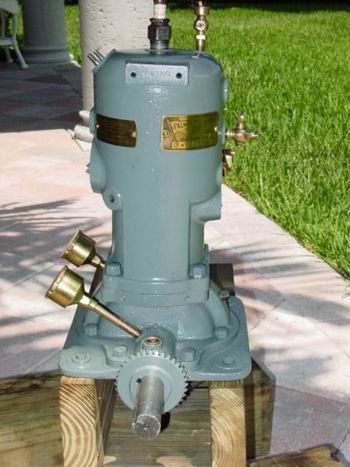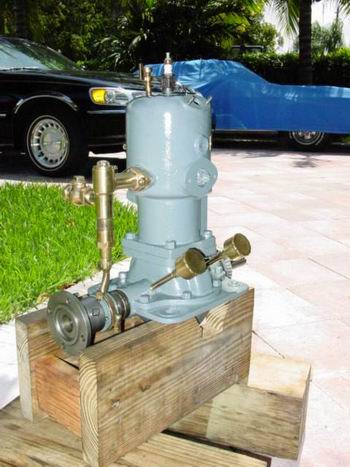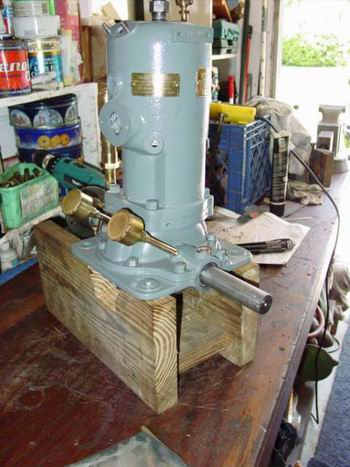|
| Author |
Message |
    
richarddurgee
| | Posted on Friday, May 21, 2004 - 03:27 pm: | 




|
My project since returning from Calvert!
1914 Palmer Q1, should be a good running little engine when finished.



 |
    
Richard Day
| | Posted on Friday, May 21, 2004 - 05:18 pm: | 




|
Beautiful job Richard. Do you have the gear guard? If you don't make sure you put cap screws in the two mounting holes or else you may have trouble trying to run it. Some of those holes go all the way through into the crankcase and others don't. Glad to see you have both tags. The mixture tags have a bad habit of disapearing. |
    
richarddurgee
| | Posted on Friday, May 21, 2004 - 09:51 pm: | 




|
Dick, Thanks, I have the gear guard and will
use sealant on the cap screws. I have been pressure testing all my two stroke engines after rebuild , saves a lot of cranking sometimes.
Noticed that the brass bushing at the bottom of the timer shaft does not have a small hole in bottom of it to allow grease from crankbearing into it, is that OK or should I drill it ??
The tags are in great condition, did notice the screws go through the water jacket, so I seal them with a dab of Permatex too. |
    
captain bill
| | Posted on Saturday, May 22, 2004 - 03:04 pm: | 




|
Looks like the crankcase has been tapped for some sort of vacuum operated accessory at some point. Palmer made a vacuum operated bilge pump.Anyone seen one? Nice job Richard. |
    
carm
| | Posted on Saturday, May 22, 2004 - 05:29 pm: | 




|
I have a Q1 of unknown vintage. I believe it is later due to the three mount studs on the water pump. I briught it nearly complete to Calvert. It needs a littly tidying up, but seein this beautiful work is an inspiration, although it means I'll have to work a little harder now. Great job! |
    
Richard Day
| | Posted on Saturday, May 22, 2004 - 09:22 pm: | 




|
Richard there is a approximately 1/16" DIA. hole on the bottom of the bronze bushing supporting the miter gear. It must get its grease from the grease cup when ever you give the forward cup a turn. Should be about every 20 to 30 minutes when under way. |
    
captain bill
| | Posted on Saturday, May 22, 2004 - 10:25 pm: | 




|
Richard, when you pressure test do you keep a "leak down" record and if so what pressure and time frame do you feel is satisfactory for a relic with no crank case seals? |
    
richarddurgee
| | Posted on Sunday, May 23, 2004 - 12:02 pm: | 




|
Dick : Drilled hole in bushing,works fine now, looks like someone forgot that step at the factory?
>
Captain Bill: Thanks, There is a pipe tapped hole in port side crankcase, have been trying to find out what its there for? can't see it in catalogs pics etc ? it looked factory done, but who knows. Have a 3 1/2 Lathrope single that has a vacuum fuel pump on it - dont think its factory but it works well.
>
No elaborate system of pressure testing , I usually put a fitting in the crank case drain and use a rubber tipped air nozzle to gently apply air, on the palmer above I put my thumb over the intake port and feel the pressure build, don't hold it but a few seconds or it will blow the grease out of crank ends. To check for external leaks I use liquid dish soap with a little water in a spray bottle, spray cases etc then pressurize and hope know bubbles show!
if piston is not at TDC the air pressure will see that it is, use caution !
>
A tightly sealed crankcase actually ensures that on the upstroke of the piston an adequate and sustained (vacuum) will be created inside it to provide proper fuel charge through the intake port. Hard starting and poor running of these old engs can be due to poor vacuum pressure. Seeems that worn two port engs can run with poorer vacuum than 3 ports, Dick Day has said that installing a two port valve in a worn out 3 port eng will help it run awhile longer. |
    
J.B. Castagnos
| | Posted on Sunday, May 23, 2004 - 07:22 pm: | 




|
At the shop I have a smoke generator for vacuum leak detection, it works well on the base of these engines. It puts out about one psi, makes leaks visible. A leak between cylinders at the crank on a two cylinder can cause a lot of problems. |
    
Duncan McDougall
| | Posted on Sunday, May 30, 2004 - 11:13 am: | 




|
I have a friend that says he has a pw27 that was made by Greenwich Marine not Palmer.They put the valves on the oppesite side so as not to infrenge on the Palmer Pat.. Have you heard of this company? Thanks Dunc, [email protected] |
    
Ernie
| | Posted on Sunday, May 30, 2004 - 07:14 pm: | 




|
To my knowledge all PW27's were identical. The PW27 used a crankcase that was made by Wisconsin. To move the valves to the other side would have required a new crankcase as well as a new cylinder. Greenwich Marine was most likely not in the position to manufacture a new crankcase as well as the cylinder. Also the intake/exhaust manifold was the Wisconsin part too. This would have had to be changed as also.
Dick.....your thoughts??????
Have a good holiday
Ernie |
    
Richard Day
| | Posted on Sunday, May 30, 2004 - 11:04 pm: | 




|
When The Palmer Engine Co. Inc. went belly up in 1971/72. Frank Hekma, one of the 1947 partners that bought Palmer Bros, Inc. of Cos Cob, CT. bought the residue from the other partners and marketed the engines and parts left over under the trade name Greenwich Marine Inc. The PW-27 was always the standard Wisconsin model AEH crankcase, valve train, magneto gearing etc. The cylinder, head, crankcase, flywheel water pump and transmission adapter to mate the Paragon OXKB to the AEH were Palmer supplied. The piston was from the Wisconsin AFH which was a larger piston than the standard AEH piston. That was how Palmer got 27 cu. inch displacement. The carburetor was the Zenith 61 series marine carburetor that looks a lot like the air cooled industrial Wisconsin version but close inspection will show the Marine carburetor has a sloped throat with a pick up tube in the bottom of the throat and a mounting flange for a backfire trap which is required in a boat. The is a PCV 1/4" or 5/16" dia. copper tube from the valve chest to the side of the backfire trap. Palmer had a contract with Wisconsin to supply the parts necessary for the the final assembly by Palmer. Wisconsin delivered a crankcase, crankshaft, gears etc. all assemble all Palmer had to do was bolt on the parts they supplied. Some individuals over the years when the water cooled jug rusted out put on an aircooled Wisconsin jug and that activity started the rumor that Palmer made and air cooled version of the PW-27. |
    
Richard Day
| | Posted on Sunday, May 30, 2004 - 11:10 pm: | 




|
Note I omitted the words "crankcase cast iron oil pan which bolted to the bottom of the Wisconsin crankcase." Sorry about the omission. |
|
|
|


|


